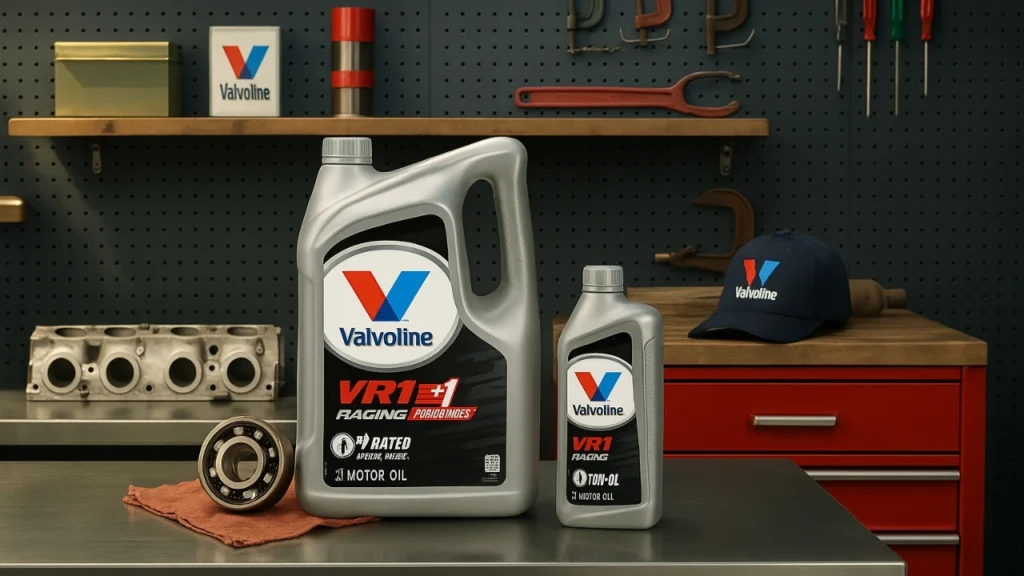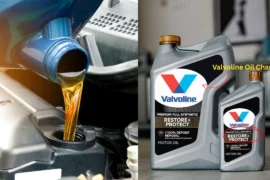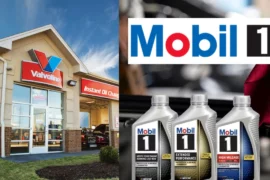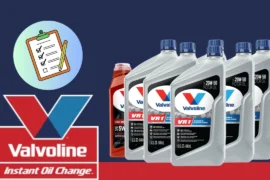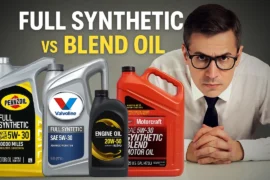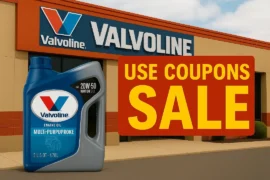Are you a motorsport enthusiast struggling with your engine? If so, Valvoline VR1 racing motor oil 10W30 is all you need. The VR1 10W30 is one of the best and most affordable high-performance lubricants on the market.
It costs around $40 to $50 for 5 quarts and is ideal for modern and top-performance engines, both on and off the track, and engines that run on alcohol-based fuels.
It provides superior protection from friction and boosts the power output while protecting all crucial parts of your engine from any wear under the extreme driving conditions you put it through.
Available in both conventional and full synthetic versions, this car lubricant can be your trusted partner for racing. To ensure smooth operation, Valvoline offers instant oil change service with an extensive 18-point inspection.
But before you go ahead and make the purchase, I recommend first making yourself familiar with its features and benefits. The good thing is that today, we will review everything about this racing motor lubricant from Valvoline and whether it is the right choice for you. Let’s begin.
What Is Valvoline VR1 Racing Motor Oil 10W30?
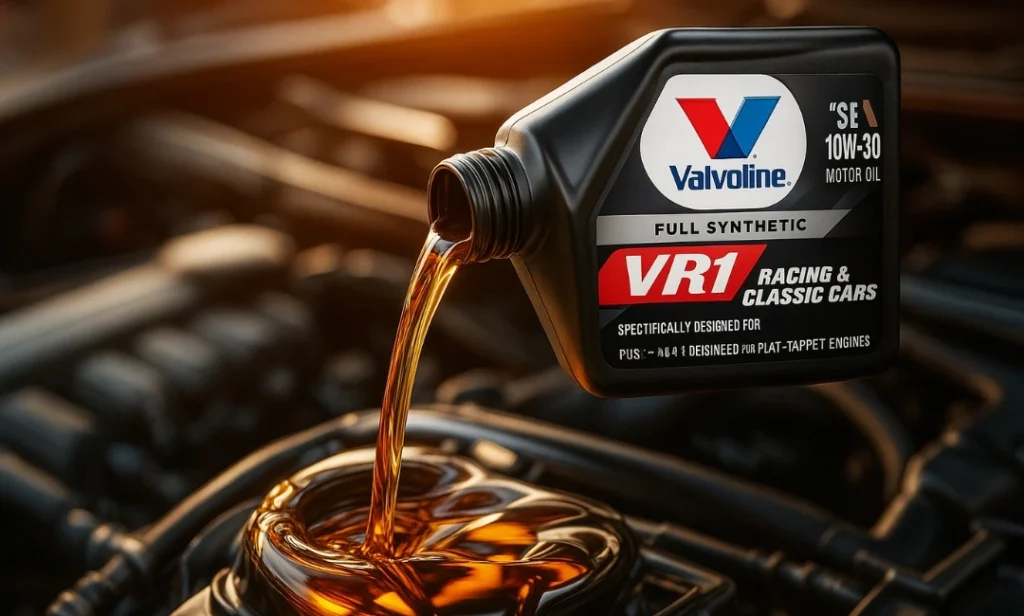
The VR1 10W30 is a chemically formulated engine oil from Valvoline. It is made for high-speed engines, typically developed for motorsports like racing and high-load driving conditions.
This oil provides superior protection for gasoline, full race, and full or partial alcohol fuel-based engines, especially the ones featuring flat-tappet and performance cam motors.
It has high zinc and phosphorus content (ZDDP) in its composition. This is impressive because it helps reduce metal-to-metal contact within engine components along with friction and wear during extreme pressure situations like speed racing or towing a heavy trailer.
The 10W30 grade is nothing but a good balance between high-temperature protection and cold start flow. Originally, it is built for the track. However, in the U.S., many muscle car fanatics and classic car owners use it for street driving. When I first learned about it I was just as baffled as you guys. But, once I understood the reason behind this usage, everything became clear.
The reason Valvoline VR1 works so well with such extravagant cars is that it is highly compatible with older engine designs. This is something most modern synthetic oils miss, making this product a viral choice.
Also, you will not find any friction modifiers in this. That is why it is not API certified for newer vehicles like the 2026 Toyota RAV4. But do not worry. As long as performance is your top priority, this is the type of oil you need to keep your engine in its top condition.
Basic Technical Features VR1 Oil
VR1 Racing Oil is not just a regular fluid you pour into your engine. It is the ultimate lubricant that ensures no harm is done even when you push your machine to its limit. There are more details associated with this product than what you may see on the surface.
- Types: It is available in fully synthetic, conventional, and high zinc concentration formulations.
- ZDDP Content: It has high levels of zinc and phosphorus, around 1400 to 1600 parts per million.
- SAE 10W30 Grade: This grade helps it offer balanced flow and strong lubrication during cold and high temperatures.
- Not API SN or SP certified: It is built for racing or heavy use like off-roading, towing, or hauling. It is not recommended for cars with catalytic converters.
- Reduce Friction: Its design allows for the reduction of friction. This leads to a decrease in the heat build-up but a boost in the overall power output. You do not have to worry about common engine issues like car backfires, engines not starting, and others.
- Enhanced Power Output: It is resistant to viscosity breakdown. Thus, it easily maintains a protective layer throughout the engine during high operating temperatures and RPMs. It helps in boosting horsepower and torque.
- Compatibility: It is safe to use in racing engines, high-performance street engines, and older classic engines. However, it is unsuitable for catalytic converter vehicles because high zinc content can cause severe damage.
- Anti-Foam Performance: Engine oil-producing foam is a regular occurrence. While not harmful, it hinders the overall performance. To avoid this, the VR1 is fabricated for minimal foaming under stress, keeping the engine cool and lubricated all the time.
- High Load-Carrying Stability: This oil has a high load-carrying capability, enabling it to protect the internal components of your engine even when you are crushing on that acceleration pad or doing some serious heavy-duty tasks.
Key Specifications
| Specification | Details |
| Viscosity Grade | SAE 10W30 |
| Base Oil | Conventional and Full Synthetic |
| ZDDP (Zinc/Phosphorus Level) | Approx. 1400–1600 ppm zinc / 1300–1500 ppm phosphorus |
| API Classification | Not certified |
| Intended Use | High-performance engines, racing, classic or muscle cars |
| Friction Modifiers | None |
| High-Temperature Stability | Excellent |
| Detergent Additives | Lower than daily-use oils |
| Catalytic Converter Compatibility | Not recommended |
| Shelf Life | Approximately 5 years |
| Oil Change Interval | Every 3,000 miles or after track sessions |
| Packaging Sizes | 1 Quart, 5 Quart, and occasionally in bulk jugs or drums |
Different Types of Valvoline VR1 Racing Oil
Valvoline offers its top-tier VR1 racing oil in more than one formulation. This makes this oil suitable for a wide range of engine needs, driving habits, and conditions.
It comes in three types that differ from each other in terms of viscosity and formulation. But one thing is common: aggressive engine protection. Also, none of these types is for regular drivers or automobiles featuring catalytic converters.
Conventional Oil
The conventional VR1 oil has the traditional petroleum-based formula, making it the best choice for hot rodders, weekend racers, and vintage car owners. It contains high levels of zinc and phosphorus and is available in three grades: 10W30, 20W50, 50, and 60.
Synthetic Oil
Available in 10W30 and 20W50 grades, this type is designed to provide excellent temperature stability and enhanced protection to the engine under extreme driving conditions. The high-heat performance and cold start flow of this full synthetic oil are better than conventional. I would recommend it for vehicles that are driven on track and cars with turbocharged setups under the hood.
High Zinc Formulas
Valvoline offers specialized blends of its VR1 motor oil. These come with different zinc concentrations, depending on the usage. Ideally, these blends are for engines that no longer support America’s modern emission system.
Pros and Cons Of Valvoline VR1 10W30
If you have reached this far into the blog, I assume you are intrigued by this impressive offering of the Valvoline, which is more than its under-15-minute oil-changing services. I have seen many people switch to this high-grade engine oil by learning what it is and how different it is from the regular options available in the market.
However, I would recommend that you not jump into the buying. First, make sure this oil is 100% what you need in an engine smoother. And the best way to do so is by learning about the pros and cons you will face with your purchase.
Pros
High Zinc Concentration:
It has high ZDDP levels that make it ideal for flat-tappet cams and older high-performance engines that need stronger protection from premature wear.
Ideal For Classic and Muscle Cars:
If you own an American muscle or vintage car, this oil can provide that cautious protection even to those older engine designs.
Available in Synthetic and Conventional Options:
Valvoline has options for both retro and modern buyers. There is a synthetic option for buyers wanting the latest tech and a conventional one for old schoolers. The former is pricier but the latter is affordable, giving you choices based on your budget and engine setup.
No Friction Modifiers:
As there are no additives, you get better clutch engagement and control of your car. This works really well in vehicles with manual transmissions and the ones built for racing.
Track-Tested Performance:
This oil is exclusively designed to perform under extreme conditions that an engine might face during racing. It can easily handle high RPM, high heat, and extreme loads without breaking down.
Cons
Not API Certified for Newer Cars:
Due to its high zinc content, this engine oil is not approved to be used in modern cars that come with catalytic converters.
May Not Be Available at All Retailers:
While you can find typical Valvoline oils anywhere from online to offline stores, VR1 is typically harder to find, especially in your local auto parts stores.
Limited Detergent Additives:
Built for racing-related driving conditions, this oil does not come with the same cleaning agents you can find in regular ones. This makes it a poor choice for daily driving and extended drain intervals.
Pricier Than Standard Oils:
This 10w30 grade engine lubricator is costlier than the standard oils available in the market. Even its conventional version can be out of reach for many. But remember that here you are not just paying for the brand name, you are also paying for the performance. Also, you can save on your purchase if you look for Valvoline promotions and coupons.
How to Use VR1 Oil Correctly
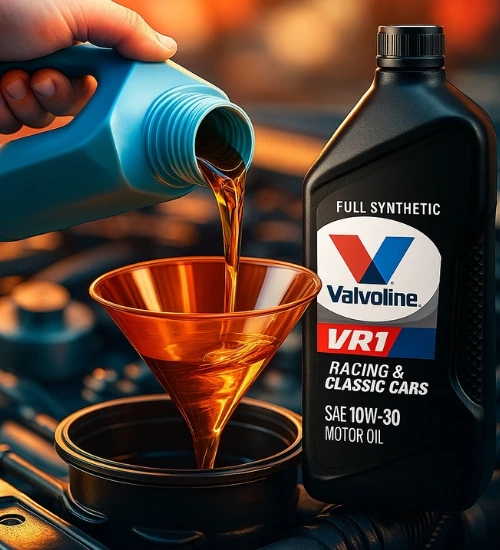
The very crucial thing you need to settle in your mind about VR1 machine oil is that it is not your regular lubricator. If not used the right way, it can actually cause severe harm to your engine. Thus, before you go ahead and purchase a bottle and start draining it down the oil tank, there are certain things you must know.
Before you can start, you need to purchase a new oil filter. The standard ones just can’t handle the high oil flow rates, thus be ready to spend. Look for high-performance or racing oil filters that:
- Can handle higher oil pressures
- Offer tighter filtration for smaller particles
- Use metal end caps and durable materials (instead of cardboard or plastic)
- Are rated for higher flow without losing filtration efficiency
Brands like K&N, WIX Racing, and Mobil 1 Extended Performance filters are solid options to go with the VR1. However, before finalizing the purchase, check the compatibility with your engine.
How Often Should You Change VR1?
VR1 10W30 is a great engine oil, but not built for long-term use. There are barely any detergents for self-cleaning, demanding frequent changes compared to the standard oils.
- Track or Racing Use: Change after every event or about 500–1,000 miles.
- Performance Use: Refill about every 3,000 miles or 3 to 6 months.
- Storage or Seasonal Cars: Always change before storing long-term, and again before taking it out on the road.
Step-by-Step Guide to Changing Valvoline VR1 Oil at Home
Valvoline VR1 racing oil is an extravagant option, but changing it does not require a village as long as you know the right way to do it. If you prefer professional assistance, take your ride to either a Valvoline instant oil change or a trusted mechanic.
However, if you are a DIYer with at least basic knowledge of automobiles, you can get the job done at home. Follow these experts-backed steps and you will be done in no time.
1. Gather What You Need
First, you need to gather all the tools and items you will need in one place. Look for:
- Valvoline VR1 Racing Oil
- A high-performance oil filter (WIX Racing, K&N, etc.)
- Oil filter wrench
- Socket wrench and drain pan
- Funnel
- Jack and Jack stands (or ramps)
- Gloves and rags
- Oil filter gasket (optional but recommended if not included)
- Drain pan
2. Turn On the Engine
First, warm up your engine oil by starting the car and sitting it idle for a few minutes. This will help in easy draining. Avoid skipping this step, as cold oil is not only hard to drain but also leaves behind excessive residue.
3. Raise The Car
Lift your vehicle to a height at which you can easily move under it. However, before you get under, just make sure the car is secured properly.
4. Drain The Oil
Before you start draining, secure the drain pan under the drain plug. Now simply remove the plug and let the oil drain. You can make the process go faster by removing the oil tank cap.
5. Remove the Old Filter
After getting rid of the old oil, remove the old oil filter and the rubber gasket as well.
6. Prep the New Filter
Before you install the new filter, rub your new oil around the rubber gasket. This negligible thing helps in better sealing and even makes it easier to remove the next time.
7. Install New Filter and Plug
Now place the new filter on the oil tank. Use the designated tool instead of your hands for firm placing. Also, reinstall the drain plug after cleaning it thoroughly.
8. Pour the New Oil
Now fill the tank with fresh oil. I recommend stopping once in the midway to check the level. This way you can avoid overflowing.
9. Check The Oil Level
To check the oil level, first warm up the oil and let it settle down, like you did in the beginning. You will now know if it needs top off.
10. Dispose of Old Oil Properly
Use a proper container to store the old oil and then take it to either a recycling center or a local auto parts store.
Pro Tip: After a day or two of driving with new oil, take time to check the oil level and signs of any leaks around the oil filter and drain plug. It is always wise to double-check. It eliminates the risk of engine damage.
Quick Maintenance Tips for Using VR1 Oil
If you wish to get the performance the Valvoline 10W30 grade oil promises, you need to do more than just pour in your tank. There are some much-needed maintenance tasks that you need to perform to be on top of your game. You can start by:
Check Oil Level Often
High-performance engines tend to burn the oil faster, leading to low levels. Make a routine to check the oil level once a month to avoid driving with little to no engine oil.
Change It Regularly
Such oils should not be allowed to sit in your engine for long. Change it every 3,000 miles.
Always Warm Up The Oil
Once you start your car, give the new oil a few minutes to warm up properly. This will ensure good flow and better lubrication.
Use Quality Filter
Always use a high-flow, high-performance oil filter. Using cheap ones will only do the harm.
Watch For Leaks
Experiencing leaks after an oil change is common, but it can happen even without that. Thus, keep taking a quick glance around drain plugs and oil filters from time to time. It can help you avoid severe engine damage.
Where to Buy VR1 and What to Look For
You can find Valvoline VR1 Racing Oil 10W30 at most major auto parts stores like AutoZone, O’Reilly Auto Parts, NAPA, and Advance Auto Parts, including their online stores. It’s also available online through retailers like Amazon, Summit Racing, and the official website of Valvoline.
Inspect these things before you buy:
Label: Check the label thoroughly and ensure it says VR1 Racing with a viscosity grade 10W30.
Confirm Type: This oil comes in different versions. So double-check that you are buying the one that matches your engine setup.
Look at the Date Code: Freshness of the oil matters a lot. Try buying the product with recent manufacturing dates, especially if you’re stocking up.
Buy From Reputable Sellers: Whether buying online or offline, purchase from reputable sellers only. Personally, I would steer clear of third-party sellers with questionable ratings.
Look Out For Deals: Some stores and online platforms offer rebates or bundle discounts. Thus, do not forget to check for the ongoing offers.

